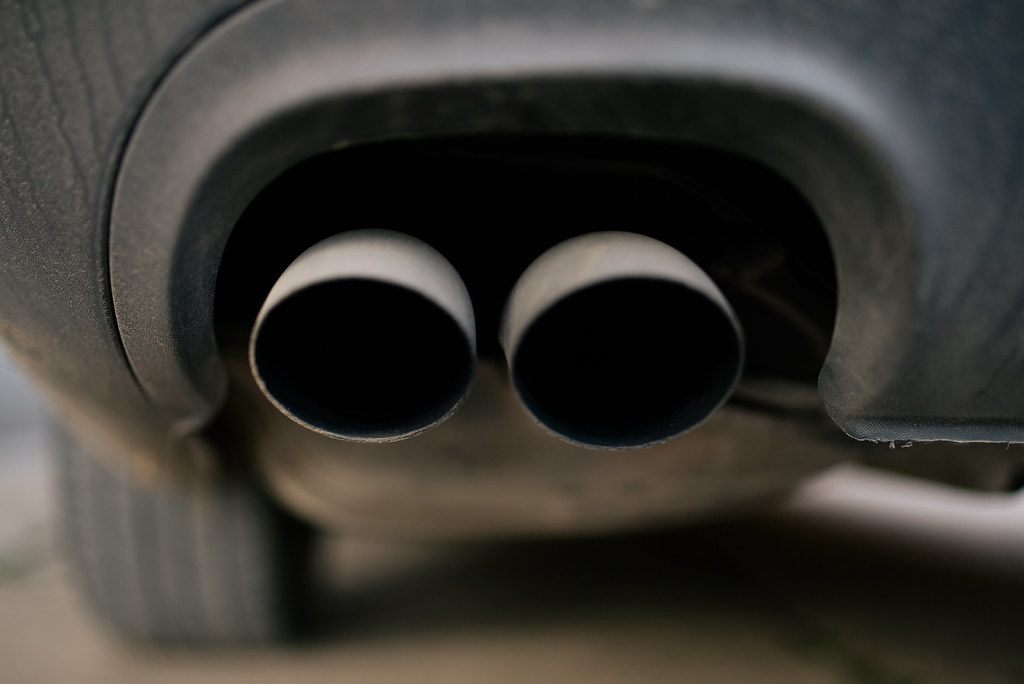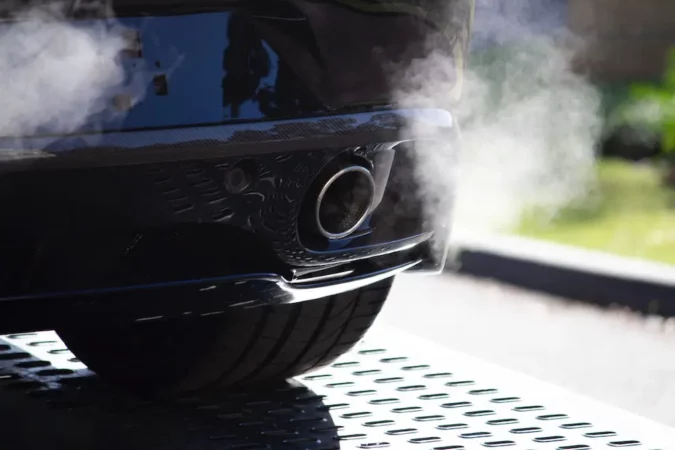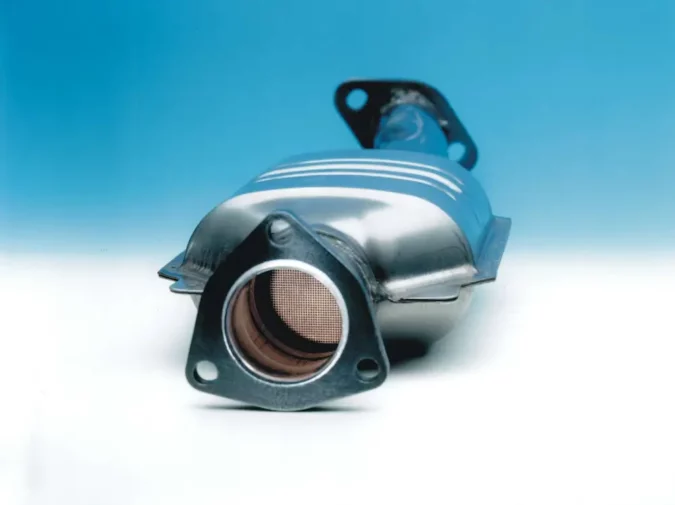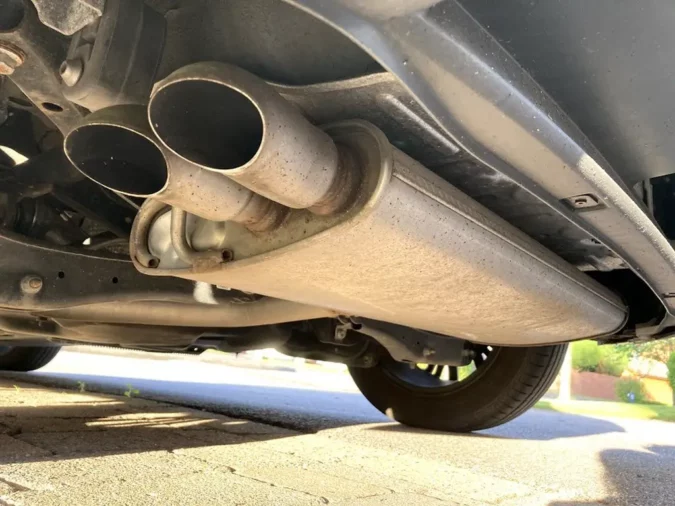As gearheads, we all love to keep our vehicles mechanically safe and sound. So, it can be concerning if you spot excessive smoke coming out of exhaust. Today, we will take a closer look at this common issue, and talk about what causes it to happen in the first place. Not only that, but we will inform you of how to fix this problem too.
Several issues can lead to smoke coming out of the exhaust system, with each different cause requiring its own unique fix. Having a better understanding of them will help you save some money once your own vehicle is faced with a smoke problem. Additionally, you’ll also learn some tips on how to minimize these problems in the first place.
So, without further ado, let’s get started. Let’s start off by taking a look at the different colors of smoke that may come out of your exhaust pipe.
White Smoke From Exhaust
On most occasions when people complain about smoke coming out of the exhaust, they are referring to white smoke.
Although some white smoke from exhaust on startup is normal, excessive smoking is a major cause for concern. Many issues can lead to this, with some of the most probable causes being,
- Condensation
- Head Gasket Issues
- Foam In Engine Oil
- Coolant Leaks
- Cracked Cylinder Head
- Fuel Octane Level
- Overheating
- Air In The System
- High Boost Levels
- Issues With Fuel Injector Pump
- Fuel Injector Failure
That’s a lot of issues to cover! So, let’s get started right away.
1. Condensation
If the white smoke is coming out the tailpipe only when your crank the engine on cold mornings, you shouldn’t be worried at all! What you are seeing is not smoke, but steam. The steam is created when the cold air outside comes into contact with the hot exhaust gases of your vehicle.
Typically, the steam will go away on its own after a few minutes of driving. It is safe to say that patience is all it takes to fix this white smoke issue. So, there’s typically not much that you have to worry about as far as water coming out of the exhaust while idling.
2. Head Gasket Issues
Next, let’s shift our attention toward a much more severe issue than mere condensation. The head gasket is responsible for sealing the combustion chamber. Ideally, it should prevent any unnecessary liquids from interfering with the combustion process.
However, failure of the head gasket allows coolant to seep into the combustion chamber, leading to white smoke coming out of the exhaust. This is among the most common symptoms of a blown head gasket.
Replacing the head gasket is no simple repair. In fact, the whole engine has to be dismantled in order for a mechanic to get to it. Therefore, a blown head gasket, where you’re possibly noticing motor oil in the coolant, is a fear most gearheads never want to face.
Fixing the head gasket is a time-consuming repair that typically takes a few days to complete. Furthermore, you are looking at a repair cost between $1600 – $2000 for typical a head gasket replacement cost.
However, head gasket leaks are not the only way in which coolant can leak into the combustion chamber. Keep this in mind, as we’ll be taking a look at the others later on in this article.
3. Foam In Engine Oil
In order for an engine to function healthily, there shouldn’t be any contaminants in the engine oil. This is why we recommend doing a dipstick check if white smoke is bellowing out of your exhaust system.
If there are foam-like bubbles in the engine oil, coolant has leaked into and mixed with it. Coolant is not an effective lubricant, and it can hamper the performance of your engine oil. As a result, there is a high risk of engine damage in this instance.
If your engine oil contains coolant, we recommend you take your vehicle to a mechanic as soon as possible. Waiting around will only make matters worse, as the coolant continues to wreak havoc on the engine’s internals.
4. Coolant Leaks
Sometimes, engine oil can escape through a crack in the block or the head gasket and mix with the engine coolant. Over time, the coolant will be replaced by foam-like oil byproducts, which give off a white smoke when burnt.
The easiest way to check for foamy coolant is by opening the radiator cap and taking a look inside. The strange smell of this liquid is another giveaway. However, make sure not to open the radiator cap when the engine is running. Instead, leave ample time for the engine to cool off before taking a peek inside.
Once you’re there, it’s worth diagnosing what causes that coolant leak in the first place. A coolant leak ought to be fixed ASAP, especially if you’ve begun to notice the symptoms of low coolant levels. Or, if the coolant reservoir tank is empty.
5. Cracked Cylinder Head
Similar to a blown head gasket, a cracked cylinder head also contributes to white smoke by allowing coolant to leak into the combustion chamber. The cylinder head is located on top of your engine’s cylinders. This component houses several important parts of an engine, including both intake and exhaust valves.
Although cylinder heads are made from durable materials like aluminum and cast iron, they are not invincible.
And once a cylinder head cracks, it lets exhaust gases back into the cylinders, leading to the formation of white smoke.
Constant overheating is the main issue that leads to cylinder head cracks. And to make matters worse, the only permanent fix or repair for a cracked cylinder head is replacing them entirely.
The average cost of a cylinder head replacement lies between $500 – $1000 but can vary depending on the material. Although you can try your luck with using a head gasket repair product off of a store shelf, we can’t guarantee its success.
6. Fuel Octane Level
Although you might not believe it at first, filling your vehicle up with the wrong octane fuel can result in white exhaust smoke. You see, when low-octane fuel is combined with another aggravating factor, it can result in engine damage and white smoke.
This is why it is important to always pump the correct octane-level fuel into your vehicle at all times. For more insight on this, be sure to check out our guide on whether can you put premium gas in any car.
7. Overheating
Continuous coolant leaks reduce the efficiency of the cooling system. As time passes, air bubbles will form inside the system, causing swings in temperature.
You can check for coolant leaks by performing a pressure test on the cooling system, checking engine vacuum levels through a vacuum test, or checking the integrity of the seals through a compression tester.
Once you’re there, you can begin figuring out the causes of your car overheating. These could even be fairly simple signs, such as how your car is running hot but not overheating, or if your car is smoking but not overheating.
8. High Boost Levels
If the car in question is highly modified, running the engine with too much boost might be the reason behind the white smoke coming from the exhaust. You see, excessive boost from either the turbocharger or the supercharger puts the engine under enormous pressure.
Sometimes, this strain might be too much for the engine block or the head gasket to bear, leading to the issues we discussed above.
9. Issues With The Fuel Injector Pump
Diesel engines rely on fuel injectors for the fuel supply. When these injectors have timing issues, an excessive amount of diesel fuel will be sprayed into the engine (which can be bad, seeing why is diesel so expensive), leading to a cloud of thick white smoke being pumped out of the exhaust pipe.
In addition to the white smoke, reduced engine performance, rough idling, surging throttle responses as well as hesitation to start are some other symptoms of fuel injector pump issues.
Oftentimes, reprogramming the Engine Control Module (ECM) resets the fuel injector timing. But, if that doesn’t fix the issue, you might have to replace the entire fuel injector pump assembly.
Contamination of fuel is the number one cause of injector pump failure. Make sure to replace your fuel filter at the correct intervals, as this is the component that removes these harmful particles from the diesel fuel.
Only filling up your vehicle at well-reputed fuel stations is another good idea if you are serious about prolonging the life of your fuel injector pump.
10. Fuel Injector Failure
The final cause of white smoke we’ll be taking a look at today is also related to the fuel injectors. These injectors are meant to be precise, and even slight deviations are enough to cause major issues.
When a fuel injector fails, it can lead to a whole host of issues. Some of the most significant ones include throttle surges, reduced RPM, bad fuel efficiency, and last but not least, white exhaust fumes. These are among the most common symptoms of a bad fuel injector.
Ideally, fuel injectors should be replaced every 50,000 to 100,000 miles. And when one fails, it usually means that it has reached the end of its service life. However, you can’t get away with replacing just one fuel injector. Instead, the entire set has to be replaced in order to ensure smooth running.
You can perform a fuel injector replacement in your home garage. This process doesn’t take much time, and a set of replacement fuel injectors can be had for around $200. In contrast, a mechanic will charge you around $150 in labor costs to replace the fuel injectors for you.
However, depending on the seriousness of the issue, the cost of a fuel injector replacement needn’t be too expensive. You could possibly get away with cleaning out dirty fuel injectors using the best fuel injector cleaner (and learn how to clean fuel injectors).
Blue Smoke From Exhaust
Although you might consider white smoke coming out of the exhaust to be somewhat normal, that is not the case with blue smoke. In fact, it can be quite alarming when you spot either blue or bluish-gray smoke exiting from the exhaust pipe.
Blue smoke might emanate from your engine due to one of the following reasons.
- Turbo Issues
- Stuck PCV Valve
- Oil Leaks
- Transmission Modulator Issues
- Faulty Glow Plug
- Issues With The Cylinder Head Valve
Blue Smoke Coming Out Of Exhaust #1 – Turbo Issues
If you drive a turbocharged vehicle and spot blue smoke coming out of the exhaust, the turbo just might be the source of your problems.
Blue smoke is a tell-tale sign of a blown turbocharger. This can be the result of either damage to the turbo casing or a broken oil seal. You can be on the lookout for these issues with symptoms of a bad turbo, such as a P0299 code.
Blue Smoke Coming Out Of Exhaust #2 – Stuck PCV Valve
The Positive Crankcase Ventilation (PCV) valve, also called the crankcase breather, is responsible for getting rid of the excess fuel pressure that builds up inside your crankcase. The PCV diverts this pressure into the intake manifold. There, the fumes are re-ignited and disposed of.
However, this valve is prone to failure. And once it does, it will cause oil to mix up with the pressurized air, which is then combusted. This mixture of burnt oil and air exits out the tailpipe as blue smoke. So, if you notice the symptoms of a bad PCV valve, it’s worth considering an immediate PCV valve replacement.
Blue Smoke Coming Out Of Exhaust #3 – Oil Leaks
Blue smoke is also produced when engine oil drips onto a hot surface of the car like the drivetrain components or the exhaust. On top of the smoke, this will give off a disgusting smell too. Blue smoke from oil leaks is most prominent when the vehicle is either accelerating or at idle.
Oil can leak out from several engine components. These include the cylinder heads, the head gasket is leaking oil, the engine oil seals, and the engine block. It is important to get a car oil leak sorted out as soon as they are discovered. Otherwise, it can be the catalyst for more severe problems.
Sometimes, the leaking engine oil gets mixed up with fuel. This typically happens when the valve-stem seals and piston rings go bad. When engine oil burns inside the combustion chamber, you can observe blue smoke coming out of the exhaust pipe.
Blue Smoke Coming Out Of Exhaust #4 – Transmission Modulator Issues
Older vehicles equipped with vacuum-controlled automatic transmissions come with a transmission modulator. Internal failures of this component can result in transmission fluid leaking into the cylinders. The combustion of this fuel is another source of blue smoke.
Blue Smoke Coming Out Of Exhaust #5 – Faulty Glow Plug
Unlike gasoline-powered cars, diesel engines do not use spark plugs. Instead, they come equipped with diesel glow plugs that heat up the air-fuel mixture for efficient combustion.
If your diesel engine is having trouble cranking, it might be time to swap out the glow plug (once you’ve learned how many spark plugs does a diesel have). Bad glow plugs also cause diesel vehicles to exhaust blue smoke, especially during start-up.
Blue Smoke Coming Out Of Exhaust #6 – Issues With The Cylinder Head Valve Guide
If the cylinder head valve guides of your engine have developed an oil leak, you will experience blue smoke. This happens when motor oil drips from the valve stem onto the fuel injector or exhaust. Blue smoke from valve guide issues is most noticeable when the vehicle is decelerating.
It is important to take your vehicle to a mechanic as soon as you notice that it is putting out blue smoke. Once at the auto repair shop, the mechanics will inspect the head gasket, valve seals, piston rings, and the PCV valve to determine the repairs that need to be performed.
Black Smoke From Exhaust
Although most gearheads cynically associate black exhaust smoke with “rolling coal” it might be very useful in indicating hidden engine problems. There are many causes for black smoke coming out of exhaust. Today, we’ll be taking a look at the following ones.
- MAF Sensor Issues
- Fuel Injector Leaks
- Piston Ring Damage
- Carbon Deposits
- Dirty Air Filter
Black Smoke Causes #1 – MAF Sensor Issues
Measuring the rate of air that flows into the engine is the main responsibility of the Mass Airflow Sensor (MAF). However, once this sensor goes bad, it can lead to excessive fuel being pumped into the combustion chamber.
The untimed detonations and burning of excess fuel manifest themselves as thick black smoke out of the exhaust. So, if you notice any symptoms of a bad MAF sensor, such as a P0102 code or a P1101 code, you should ideally start planning the cost of a new mass air flow sensor.
Black Smoke Causes #2 – Fuel Injector Leaks
Leaking fuel injectors are another main cause of black smoke coming out of exhaust. When a fuel injector is leaking, unburnt fuel may enter the combustion chamber. The resulting carbon buildup may cause the exhaust smoke to turn black in color.
Black Smoke Causes #3 – Piston Ring Damage
The piston rings are an essential part of any engine. They prevent the leakage of engine oil into the combustion chamber. However, the piston rings can get damaged over years of use, resulting in the engine oil mixing with the fuel. When this unhealthy mixture is burnt, a heavy black smoke cloud is created.
For more references, do check out our guide on the replacement cost of new piston rings.
Black Smoke Causes #4 – Carbon Deposits
Carbon is the main culprit behind the black-colored emissions from your engine. The continuous presence of fuel, oxygen, and heat inside an engine leads to the formation of these carbon particles. Over time, these can clog up internal engine components, such as the fuel injectors and the cylinders.
Carbon buildup is not healthy for an engine. It can harm the fuel economy, and damage critical components like the EGR valve. Black smoke from the exhaust is one of the main symptoms of carbon buildup.
Black Smoke Causes #5 – Dirty Air Filter
As you may already know, oxygen is an integral element in combustion. In order for an engine to produce power, it has to draw in air from the atmosphere and combine it with fuel before igniting it. This atmospheric air has to pass through the air filter in order to make it to the combustion chamber.
If the air filter is clogged by either dust or debris, the engine won’t receive enough airflow. As a result, an excess amount of fuel will get burnt, leading to the unfamiliar sight of black smoke coming out of the exhaust. In addition, poor airflow will negatively affect your vehicle’s fuel economy as well.
As such, if you have a dirty or clogged air filter, it might be worth considering the cost of a new engine air filter (make sure you’re wary of how much are air filters for cars).
Grey Smoke From Exhaust
Similar to the other shades we discussed so far, seeing grey smoke coming out of the exhaust of your vehicle can be very concerning. Similar to blue smoke, the main cause behind gray smoke is the presence of oil in the combustion chamber. However, motor oil is not the sole cause of grey exhaust smoke.
Grey Smoke From Exhaust #1 – Jammed Turbo
If you are experiencing slow accelerations and excessive oil consumption simultaneously with the gray smoke, you should direct your attention to the turbocharger. It can either be jammed, or the internal components might have worn out. In any case, it is better to get the turbo issues sorted out before they cause much harm to the engine.
Grey Smoke From Exhaust #2 – Transmission Leaks
Leaks in the transmission system and the array of lines and hoses connected to it can be another possible cause of grey smoke. Owners of vehicles equipped with automatic transmissions should especially be worried about this problem. A transmission fluid leak can also cause further damage to your transmission.
Grey Smoke From Exhaust #3 – Faulty PCV Valve
The Positive Crankcase Ventilation valve controls the emissions of your engine by drawing unburnt fuel back to the top of the engine. When this valve goes bad, the unburnt fuel may remain inside the combustion chamber, causing gray smoke to exit out of the exhaust.
Smoke Coming From Engine
If the smoke is coming from your engine and not out of the exhaust, there is a high possibility that your car is overheating. Issues with the cooling system are the most common cause of engine overheating.
However, other reasons like lack of lubrication, faulty wiring, and residue on the engine can also result in white smoke coming from your engine.
Smoke Coming Out Of Exhaust: Final Verdict
Smoke coming out of the exhaust of a vehicle is not a good sign, and it gets much worse when the smoke gets a hint of color. Blue, black, grey, and white are the most common shades of smoke vehicle owners complain about.
Each of these colors of smoke is caused by its own unique set of problems, and it is important to remedy those causes before they cost you thousands of dollars in repair bills.
Frequently Asked Questions
If you’re curious to learn more about this, our FAQs here might help…
Why Is My Car Smoking
Overheating is the main reason why smoke is coming out of your engine. In this case, you should pull over at a safe spot and let the vehicle cool down to prevent further engine damage.
What Does White Smoke From Exhaust Mean
White exhaust smoke can be caused by a variety of issues. The most common causes include condensation inside the exhaust system, coolant leaks, foam in the engine oil, overheating, and filling up the engine with the wrong octane-level fuel.
What Does Blue Smoke From Exhaust Mean
Blue smoke from the exhaust mainly occurs due to the mixing of engine oil and fuel. Damage to the turbocharger, issues with the transmission modulator, and faulty glow plugs are some other causes of blue exhaust smoke.
How Hot Do Car Exhausts Get
The exhaust system is one of the hottest areas of a car. The average temperature falls anywhere between 400 to 500 degrees Fahrenheit. Sports exhaust systems take this one step further, with temperatures reaching as high as 1000 degrees Fahrenheit.
Can A Bad Thermostat Cause A Blown Head Gasket
The thermostat is what regulates the coolant flow through the engine. Failure of this important component can lead to engine overheating, which in turn can lead to head gasket issues.





